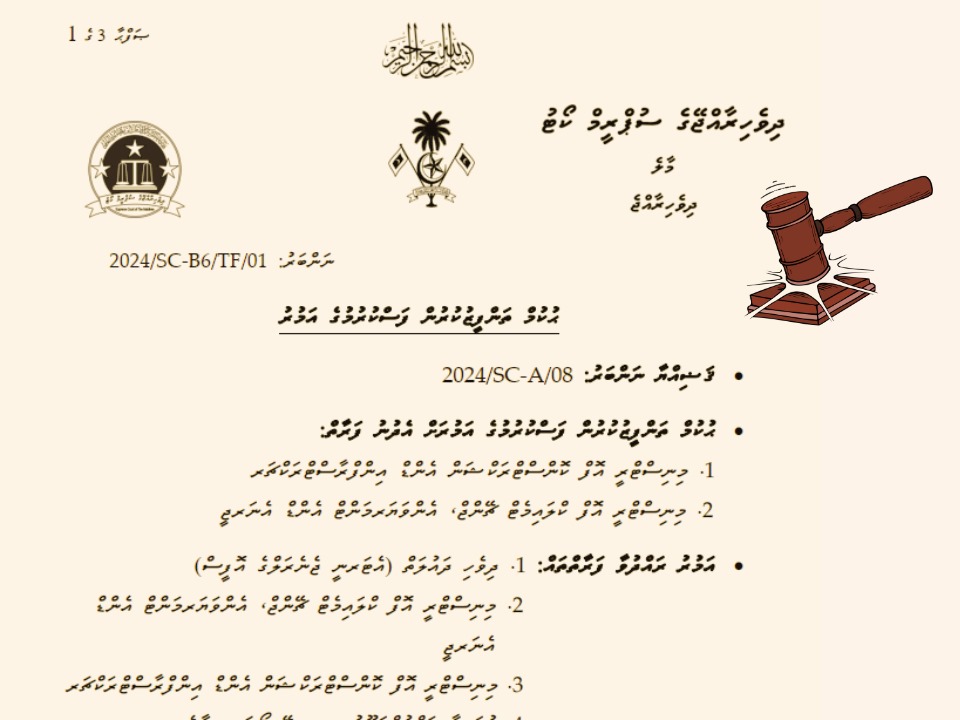On the subject of Respondent (State) appealing the High Court’s TSO decision at the Supreme Court and the Supreme Court’s order to delay the implementation of the High Court’s judgment
Miveshi – Press Statement
15 February 2024
Male’, Maldives
1 – I submitted a case to the Civil Court of the Maldives to stop the project to develop a port at Kaafu Gulhifalhu in September 2021.
While that case was ongoing at the court, the project proponent, the then Ministry of National Planning, Housing and Infrastructure announced on 2 March 2023 that the second phase of the dredging project would begin. Therefore, on 15 March 2023 a request was made to the Civil Court for a temporary injunction to stop further reclamation until a decision was reached about the ongoing case.
a) The submission requesting a temporary injunction was made on 15 March 2023.
The Civil Court reached a decision about the temporary injunction on 8 June 2023 and this information was communicated to the applicant on 10 June 2023.
b) An application appealing the Civil Court’s decision was submitted to the High Court on 18 June 2023. This application was accepted by the High Court on 24 August 2023. The High Court reached a decision on this appeal application on 14 February 2024.
c) The above information shows that when an ordinary citizen applies to the Civil Court for a temporary injunction, the Civil Court took approximately 3 months to reach a decision. Additionally, in the case submitted to the High Court, the process of initial submission, acceptance by the court and reaching a decision took a period of approximately 8 months.
2 – Detailed information of how this case has been progressing in the courts are published and updated on the Miveshi.com website.
3 – The Maldives High Court issued its decision on 14 February 2024 granting a temporary injunction to stop further reclamation of Gulhifalhu until a decision is reached about the ongoing substantive case at the Civil Court, with the objective of preventing irreversible destruction to the environment. Notably, this decision was made with due and comprehensive reference to the submitted evidence and the legal rules and principles presented to the court.
4 – However, when the State appealed the High Court’s decision at the Maldives Supreme Court on 15 February 2024, using the powers vested under section 21 of the Court’s regulation, the Supreme Court allowed the State’s application ordering to halt the implementation of the High Court’s decision until such time as the Supreme Court decides otherwise. What this means is that the evidence submitted to the High Court has been set aside, and both the perceived financial damage to the State and the irreversible and fundamental damage that would be caused to the ordinary public were weighed using the same measure.
5 – The time period involved in the processes outlined in point 1 above and the time period relevant to point 4 above show a notable and significant discrepancy. Courts of law are institutions that should function using equitable processes in the provision of public services. It is notable that the process of the State’s appeal application was completed at high speed, within a period of less than 24 hours. The incomparably significant processing time discrepancy between an application by an ordinary member of the public and that of the State are notable.
6 – The Supreme Court’s order states that the reason for its issuance is because : “if the implementation of the Maldives High Court’s decision is not halted now, the probability of severe harm to the State is clearly evident.” In relation to this point, it is notable that section 6 of Law No. 4/93 (Maldives Environment Protection and Preservation Act) states the following in relation to project stoppage.
“The Ministry has the authority to stop any ongoing project if the project is found to be causing negative impacts to the Maldives’ environment. There will be no compensation provided to a project stopped in these circumstances.” (unofficial translation)
7 – 2 points of note arise from point 6 above.
a) Firstly, is the Gulhifalhu project created in such a way that Maldivian national laws are not applicable to it.
b) Secondly, there is no clarity that the decision alleging severity of the anticipated losses that would be incurred if the High Court decision is implemented, has been made on the basis of any submitted evidence.
8 – While it has been decided that the High Court’s temporary injunction to stop further reclamation of Gulhifalhu until a decision is reached about the ongoing substantive case at the Civil Court, is not to be implemented, the fact that there has be no valuation of environmental damage as a result of project continuation does not mean that irreversible environmental damage is not happening. Moreover, it is evident that the Gulhifalhu reclamation project has been continuing without any valuation of environmental damage. However, the only project that had valued reef loss impact in the Maldives, the Addu reclamation project shows that the loss of reefs amounts to hundreds of millions of dollars of damage. Without making such valuations, and continuing to destroy the country’s environment using omission to conduct such valuation as a means of not establishing the extent of the damage being done, is a betrayal of present and future generations.
Appellant – High Court appeal case
Humaida Abdulghafoor, H. Shady Corner, Male’

